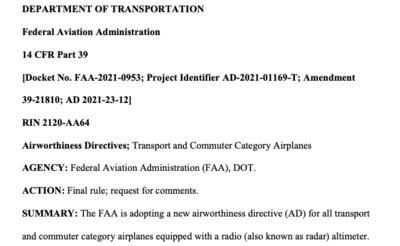Wed, Dec 08, 2021
AFMs to Prohibit Radio Altimeter Use by NOTAMS At Appropriate Airports
The FAA has issued 2 new airworthiness directives regarding the impending (and temporarily postponed) rollout of 5G networks.

An addition to the approved AFMs for transport and commuter category aircraft will be amended with updated radio altimeter flight restrictions, for select locations to be named by NOTAMs for the area. The agency also invites aeronautical, avionics, and telecommunications companies to help identify exactly which areas are most likely to develop signal interference or altimeter errors. The agency is on a shorter timeline than usual, noting that a number of 5G network providers are due to begin service in January 2022. The public has 45 days to review and comment on the changes, with the amendments effective once published to the federal register.
The FAA plans to use the data provided by telecomms providers to determine exactly which C-Band base stations or similar technology that would impact altimeter operation at the appropriate airports. Of course, the change in usable instrumentation could significantly alter approach procedures, noting "these limitations could prevent dispatch of flights to certain locations with low visibility, and could also result in flight diversions."

Directive 01169-T specifically notes that although the normal, lengthy issuance process has been omitted, "the FAA has found that the risk to the flying public justifies forgoing notice and comment prior to adoption of this rule because radio altimeter anomalies that are undetected by the aircraft automation or pilot, particularly close to the ground (e.g. landing flare), could lead to loss of continued safe flight and landing. The urgency is based on C-Band wireless broadband deployment, which is expected to occur in phases with operations beginning as soon as January 5, 2022. Accordingly, notice and opportunity for prior public comment are impracticable and contrary to the public interest."
More News
Airport Marking Aids Markings used on runway and taxiway surfaces to identify a specific runway, a runway threshold, a centerline, a hold line, etc. A runway should be marked in ac>[...]
"It is extremely difficult, if not impossible, for manned aircraft to see a drone while conducting crop-enhancing and other aerial applications at low altitudes and high speeds. We>[...]
Aero Linx: The Skyhawk Association The Skyhawk Association is a non-profit organization founded by former Skyhawk Pilots which is open to anyone with an affinity for the A-4 Skyhaw>[...]
“The T-54A benefits from an active Beechcraft King Air assembly line in Wichita, Kansas, where all required METS avionics and interior modifications are installed on the line>[...]
Aero Linx: Aerostar Owners Association The Association offers the Aerostar Owner a unique opportunity to tap an invaluable source of information concerning the care and feeding of >[...]
 ANN's Daily Aero-Term (04.28.24): Airport Marking Aids
ANN's Daily Aero-Term (04.28.24): Airport Marking Aids Aero-News: Quote of the Day (04.28.24)
Aero-News: Quote of the Day (04.28.24) ANN's Daily Aero-Linx (04.28.24)
ANN's Daily Aero-Linx (04.28.24) Aero-News: Quote of the Day (04.29.24)
Aero-News: Quote of the Day (04.29.24) ANN's Daily Aero-Linx (04.29.24)
ANN's Daily Aero-Linx (04.29.24)




